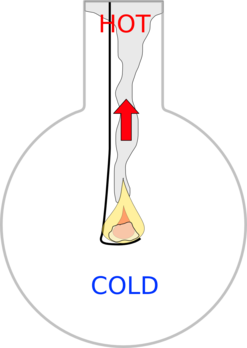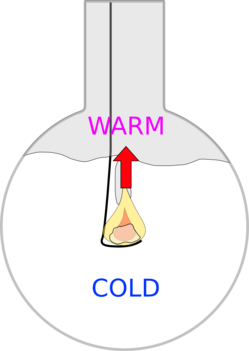Phosphorus Moon
Ingredients
Phosphorus is a very reactive element that can exist in several different allotropes or structures. It gets its name which means light-bringer in Greek, because white phosphorus will glow when exposed to the oxygen in the air. Energy released by the phosphorus slowly oxidising (burning) is given off as light.
But
Dr Hal wanted to release the energy more rapidly, so he filled a large jar with pure oxygen and then lit a piece of phosphorus and then sealed the jar.
Explanation
White phosphorus burns in the oxygen to form phosphorus pentoxide and lots of energy.
P4 + 10 O2 -> 2 P2O5
This means that the gas in the smoke is very hot, so the smoke rises and is rather beautifully lit by the light given off by the flame.
The smoke is made up of tiny lumps of solid P2O5 suspended in gas. These lumps weigh the gas down so that when the smoke cools enough it will sink through the colder air at the base of the chamber.
This sinking produces the beautiful tendrils as the smoke falls and the air rises to take its place,
 |  |  |
|---|---|---|
| The phosphoro=us burns vigorously in the oxygen forming clouds of hot phosphorus oxide smoke | The smoke slowly builds up and cools down | Eventually the smoke cools enough that the particles of phosphorus oxide make the still warm air denser than the cold air below. So they fall down forming tendrils. |
- Previous The Barking Dog Experiment
- Next Exploding Eggs - Burning Hydrogen









Comments
Actually the moon is a
Actually the moon is a phosphor itself.
Are you saying the moon could
Are you saying the moon could be made of a reactive substance like white phosphorus?
No, and it doesn't say that
No, and it doesn't say that anywhere on the page. The experiment is merely called a "phosphorus moon" owing to its resemblance to the full moon.
Add a comment